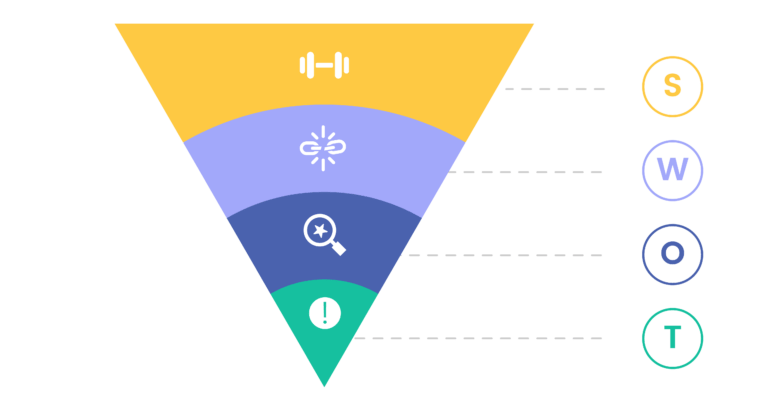When you interact with a salesperson, it may feel like the sales process is spontaneous. In fact, this could not be further from the truth. Whereas sales does involve a great deal of creativity, companies see the best results when they have a sales process in place. This aligns sales with the company’s wider business goals, improves close rates, and results in great customer satisfaction to promote word-of-mouth marketing.
What Is a Sales Process?
Before going further, it’s important to be clear about what we mean by a sales process: it’s a series of actions a sales team uses to turn a lead into a customer. The sales process comprises the tactics the sales team uses to position products, sales best practices, and overall objectives. Companies that have a formal sales process see 28% higher revenue growth, according to a Harvard Business Review survey.
However, the sales process is not rigid — it needs to be flexible enough to suit the different needs, concerns, and problems of each individual customer. In addition, you may need to change your sales process in response to new challenges or changes in your industry or if you find a particular tactic is leading to low returns.
The benefit of having a sales process is it gives your sales team a roadmap to convert leads based on proven tactics. This is useful for giving the current sales professionals on your team guidance, but where it comes in extra important is in onboarding new team members. With a defined sales process, you avoid losing leads your marketing team have generated, nurtured, and provided to your sales team.

Sales Process Steps
The sales process is made up of a number of steps. Although each company needs to customize these steps to make them relevant for its customers, you can use the following as a template.
Step 1: Prospecting
It’s only possible for your sales associates to convert customers if they have plenty of leads. You acquire these leads through prospecting.
To design the prospecting step of your sales process, you first need to determine what characteristics you are searching for in a customer. You should use these to develop an ideal customer profile (ICP). Next, you’ll need to decide how you’ll find leads with these characteristics. You have multiple options to find potential customers, including online databases, by contacting users on LinkedIn, and by networking at industry events. Prospecting can also involve reaching out to current customers for referrals.
Step 2: Contact
You’ll be limited about what you know about individual leads until you’ve contacted them. It’s important to learn plenty about a lead early on, both to ensure it’s an opportunity you want to pursue and to identify how you’ll tailor your strategy going forward for the lead. In particular, you’ll need to learn about the challenges the lead is facing — this will enable you to position your offering as a solution.
Determine the best way to reach out, whether that’s a message over whatever platform you used to find the lead, email, or phone call. Create a script your sales team can use to introduce your company and offerings and ask questions to find out more about the lead’s needs. For B2B sales, your rep may need to talk to multiple people at the company to gain a better overall picture of the situation.
Bear in mind you’re not pushing for a sale at this point: the main purpose of the conversation is to qualify leads to see if they meet enough of your criteria to be worth pursuing. Most importantly, they should need the service you’re offering, have the budget to afford it, and have the authority to make the purchase. Determine the questions your reps will use in the sales process to discover this information.
Step 3: Nurture
Use the responses you received to determine how to nurture leads. You may need to provide leads with more information about the benefits of your service, how you’ll be able to solve the problems they’re facing, or why you have a better solution than a similar service from a competitor.
You’ll need to provide your sales team with ideas for responses to common queries and relevant information for leads at every stage of awareness — from unaware they have a problem to already aware of your solution. You’ll also need a strategy to maintain contact with leads who are not quite ready to convert just yet.
Step 4: Pitch Your Solution
Depending on how qualified a lead is, you may be able to skip nurturing and go straight to your pitch. Although you’ll need to customize your pitch to emphasize the features that matter most to the lead, your sales associates should base their presentations on what has been successful in the past.
Consider if it would be beneficial to involve other members of your team at the stage. For instance, an engineer may be able to answer leads’ technical questions, whereas having an executive present could show that your business will be committed to a customer’s account.
Since creating a personalized pitch may require a large amount of the salesperson’s time, it is crucial you only move to this stage when you’re confident a lead is sales qualified.
Step 5: Respond to Objections
You should expect every lead to make objections — this won’t necessarily always be the case, but anticipating objections will ensure you’re prepared. Ask sales reps to compile a list of all the objections they’ve received in the past and create suitable responses. It’s likely some members of your sales team already have responses everyone can begin to use.
Make sure your sales reps know they need to take their time when responding to objections — no matter if the lead is concerned with cost, risk, onboarding, contract terms, or something else. Showing empathy, listening, and allowing the lead time to think about your offer will ultimately improve the relationship. It is also worth asking your own questions to make sure there’s not another reason your lead is hesitant.
Step 6: Close
To close a deal, you may need to find ways to incentivize leads to take action as soon as possible — before they lose momentum. Some tactics your sales team could employ include:
- Limited-time offers
- Bonuses for signing up immediately
- Creating a sense of scarcity
Stage 8: Retaining and Continuing to Sell
Your sales team should stay involved with customers after they’ve closed deals. This may mean working closely with the customer service team to address any concerns that could cause the loss of a customer. It’s also necessary to understand customers’ changing needs for potential cross-sell or upsell opportunities. Finally, ensuring customers are content will increase the chance of referrals.
How to Create a Sales Strategy for Your Company
Now you’re familiar with the different stages of the sales process, it’s time to create one for your company. Follow these tips to see the best results.

1. Evaluate Your Current Process
Before you implement a sales process, it’s important to assess what is currently working and where you need to make improvements. There are a couple ways to approach this.
One is to monitor your sales associates. Review the process your sales reps are using from the moment your marketing team hands them a lead to the point they close a sale. Consider the touchpoints your sales team uses, the actions the leads take, and the timeline of the process.
Another approach is to talk to your sales team directly. You can gain insights into the sales process by asking reps about the challenges they face, the tactics they use, and where they feel their strengths lie.
2. Know Your Customers
A strategy that works well at one company could be completely unsuitable for your business due to differences between customers. It’s important to know who makes up your customers, including their demographics, needs, and motivation for buying from you. Once you know this, it will be clearer where to find qualified leads and what you need to do to pitch your offerings effectively.
3. Identify Triggers and Bottlenecks
Determine what triggers cause leads to move through the sale funnel and where bottlenecks are forming. You can then utilize these triggers to increase your number of conversions and identify the reasons for bottlenecks to prevent leads from dropping off.
Bear in mind that triggers and bottlenecks are often related: a bottleneck may be occurring because your sales team is failing to take the next necessary action. For example, a lead may need a piece of content, information, or offer to move to the next stage.
4. Establish Milestones for the Sales Process
Use the triggers you defined to establish milestones. This will allow your sales team to identify where a lead stands and what action you need to take next. It will also prevent reps from skipping to subsequent stages too early, which can ruin your chances of converting a lead.
Having said that, it is important your reps take into account that not all leads will be entering the sales funnel in the same place. Leads you cold call may be completely unaware of your business or only have a vague idea of your offerings and therefore require significant nurturing. In contrast, inbound sales calls are hot leads who may be close to converting to customers — they may just need a little extra information before they decide to purchase. In addition to treating leads differently according to how qualified they are when they enter the funnel, your sales team should prioritize those that are most likely to convert.
5. Measure Results and Adapt as Necessary
You need to constantly make changes to your sales process to keep improving it. This will also allow your sales process to reflect new offerings, evolving customer needs, and changes in your industry. Regularly experiment with fresh ideas and measure the results to see if they have a positive effect on your sales goals.
Top Sales Tactics to Use
To complete your sales process, you need to consider some tactics you can use. The right tactics for you will depend on factors such as your industry, your target audience, and the resources you have available.
Storytelling Through Content
Putting your offering into context can help leads see how it will benefit them. A great way to achieve this is through content that tells a story about how your offering helped other customers solve a problem. Your sales team will need to provide leads with a story that most closely aligns to their own situation.
Storytelling is particularly ideal for coaches because it allows them to give real examples of how they’ve improved the lives of their clients. However, coaches often have only a small team — at the most. This makes implementing a sales process on top of all their other day-to-day duties especially challenging. A virtual assistant who can carry out the tasks they lack the time or expertise to themselves can be invaluable for coaches.
Thought Leadership
If your business operates in a niche area, potential leads may be limited. However, it also means there are few other people who have anything close to the expertise you possess. Positioning yourself as a thought leader can help demonstrate your knowledge. To use thought leadership as a tactic, though, it’s crucial you know what your audience wants. If you misjudge their needs, you could end up making prospects feel like your offerings are aimed at someone else.
Free Trials
The most effective free option to convert leads is a free trial, according to the 2023 Sales Strategy & Trends Report from HubSpot. This is useful for converting leads who are unsure if they are ready to purchase by showing them exactly what they’ll receive. You can provide a free trial for a limited time or offer just a selection of your full range of features. Since a free trial requires no commitment on behalf of the lead, you can introduce it early in the sales process, including to leads you cold call.
Product Demonstrations
If you’re unable to offer a free trial, an alternative could be to provide a demonstration. This is useful when leads are hesitant because they’re unsure about exactly what they’ll receive from your offering.
Flexible Offerings
It can be useful to make adjustments to your offerings if this will mean they become more appealing to a lead. For instance, you could change your services or support to better meet a customer’s needs. Small businesses tend to be in the best position to take advantage of this tactic. However, it’s important to bear in mind that being flexible may create more work for your team — and you may already be functioning at full capacity. In this case, your best option is to gain extra help with tasks that don’t require the expertise of your in-house team. The most affordable way of doing this is with a virtual assistant for small businesses.
The Importance of Having an Experienced Sales Team
Only skilled and experienced salespeople will be able to take the sales process you create and put it into action without delay. If you have inexperienced reps on your team, you may need to spend time training them — and you can expect some mistakes that may result in you losing leads. Experienced sales professionals, on the other hand, are likely to have their own ideas to enhance the sales process further.
Key Skills for Selling
Choose the right candidates to hire by considering their skill set for selling. In particular, the following are necessary in a skill set for a sales associate:
- Listening skills — Sales are about far more than making a pitch to a potential customer. In fact, listening is more important than talking — only by listening can you find out what problems a lead needs to overcome and position your service accordingly.
- Organizational skills — Many roles require good organizational skills, but this is especially pronounced in sales. Being organized ensures a rep knows everything about a lead and suitable offerings before beginning a conversation.
- Flexibility — Sales reps may need to change tactics midway through dealing with a lead if they realize their current approach is not working. For example, they need to react appropriately to a lead showing hesitancy. This requires flexible thinking. Another reason flexibility is important is because you may need to ask reps to use quite different tactics than what they are used to. They need to be willing to follow your sales process, rather than rigidly sticking to a method they have always used in the past.
- Persistence — It is likely that more leads will fail to convert than will become customers. The best sales associates never become disheartened. Instead, they strive to do better next time and learn from their mistakes to improve their numbers going forward.
- Motivated — It is only possible to meet your sales targets if your reps care. You need to be passionate about what you do and be willing to go the extra mile to ensure you close as many sales as possible.
Reducing Workload with a Virtual Assistant
Your sales reps will be most effective at selling if they are able to fully focus on the sales process. Unfortunately, selling involves a large amount of administrative work, which falls to salespeople, even though it doesn’t require their unique skill set. For instance, reps need to book appointments with leads, update their CRM, log their interactions, and create reports. A virtual assistant for sales can take on all these tasks and many others, freeing up your sales team for skilled work. Schedule your free trial with a virtual assistant who specializes in working with sales teams from myVA360.










